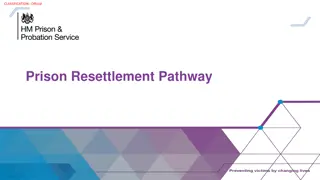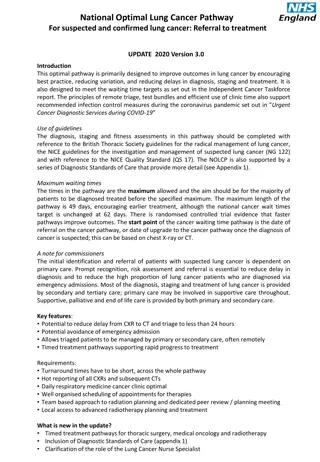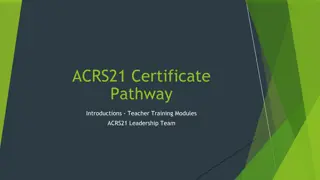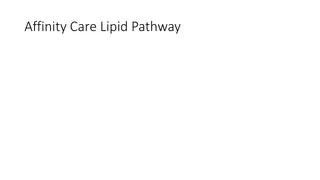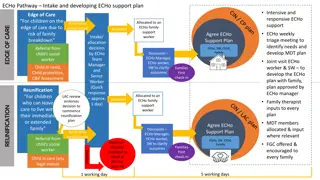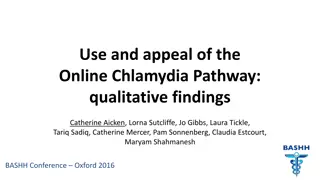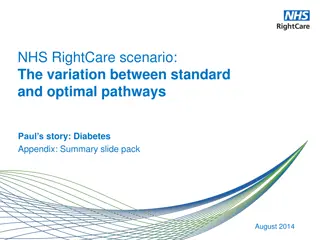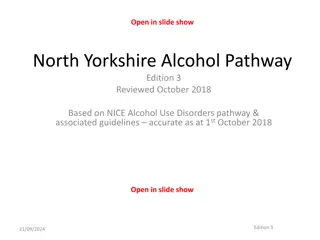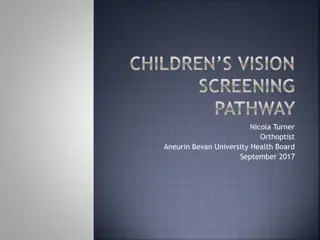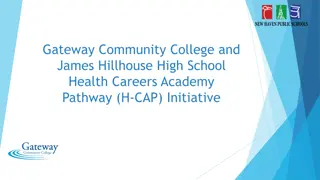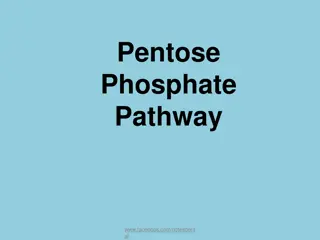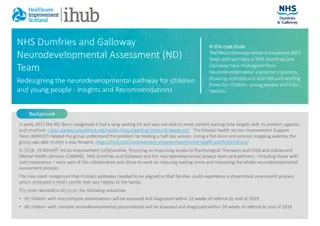Understanding the Journey Person Pathway in Education
Increase understanding of the apprenticeship pathway, secondary school options, and strategies for supporting students interested in becoming a journey person. Address challenges in promoting apprenticeships and supporting students in taking their first post-secondary steps towards this career path. Highlight resources and opportunities available for students and educators.
Download Presentation

Please find below an Image/Link to download the presentation.
The content on the website is provided AS IS for your information and personal use only. It may not be sold, licensed, or shared on other websites without obtaining consent from the author. Download presentation by click this link. If you encounter any issues during the download, it is possible that the publisher has removed the file from their server.
E N D
Presentation Transcript
1 SCWI/IJECT
Introduction Background materials sent in advance Webinar presentation, including guest speakers, survey of participants needs Follow-up online session for additional Q s and A s and sharing 2 SCWI/IJECT
Goals of the webinar 1. Increase understanding of the pathways to becoming a journey person 2. Outline various secondary school options leading to becoming a journey person 3. Match the right student to the right program at the right time 4. Share successful strategies for student selection and support 5. Highlight current, accurate and user-friendly resources 6. Identify first post-secondary steps for graduates interested in becoming a journey person 7. Identify additional needs of educators working with students interested/considering the apprenticeship pathway 3 SCWI/IJECT
Challenges: What have we learned? The apprenticeship pathway is still not as well known or understood Different from other post-secondary options (college or university) in terms of application processes, and how and where learning takes place Wrap Around SWAC and Wrap Around ADC: interest in apprenticeship and need for support to take next step Students may only become interested towards the end of secondary school or later, regardless of opportunities while in school 4 SCWI/IJECT
Challenges: What have we learned? How do we/can we support students to take the first post- secondary step towards becoming a journey person? 5 SCWI/IJECT
Increase understanding of the journey person pathway Becoming a journey person Alternating periods of on-the-job (~90%) and in-school training (~10%). Most learning takes place on the job Opportunities in secondary school to prepare for and to begin an apprenticeship Two groups of students with different needs Ones who already know who they want to become Ones who have no plan but might be interested in learning about this option 6 SCWI/IJECT
https://oyap.com/oyap/ 7 SCWI/IJECT
The journey person pathway Alternating periods of learning on- the-job (~90%) and in-school training (~10%) Work Co-op Pre-apprenticeship program (MLTSD Funded) Graduate from Secondary School Apprenticeship Diploma Program Work and get a Registered Training Agreement (RTA) Signed College Technician or Technologist Diploma Program College Become a qualified journey person University 8 SCWI/IJECT
The journey person pathway Alternating periods of learning on- the-job (~90%) and in-school training (~10%). Co-operative Education SHSM OYAP Work Co-op Pre-apprenticeship program (MLTSD Funded) Graduate from Secondary School Apprenticeship Diploma Program Work and get a Registered Training Agreement (RTA) Signed College Technician or Technologist Diploma Program College Registered Training Agreement Tech Dual Credit Become a qualified journey person Level 1 In-school Apprenticeship University 9 SCWI/IJECT
Pathways to Apprenticeship Matching students with the appropriate opportunity, one student at a time. Adds clarity to a number of policy documents (http://www.edu.gov.on.ca/eng/teachers/stu dentsuccess/oyap.html ) 10 SCWI/IJECT
Secondary school opportunities leading to becoming a journey person Pathways to Apprenticeship, 2017. P. 8 http://www.edu.gov.on.ca/eng/teachers/st udentsuccess/PathwayApprentice.pdf 11 SCWI/IJECT
SCWI Approved Activities and Forums, 2021-22* Connecting Science/Technology and College Pathway (Cambrian) TNT Workshops for Young Women Grade 8 10 (Conestoga) Level 1 RTA sign up night and pre-orientations (Cambrian) PSTT (Promoting Skilled Trades & Techs) (York Region DSB and GTA colleges) Level 1 Math Project - Revisions & Ongoing Workshops (Canadore) Trades Promotion (Lambton) Trades and Technology Day (Fanshawe) Careers Hospitality with Multi boards Gr. 7&8+ (Centennial) NWO Women in Tech and Trades Conference (Confederation) Activit 7e et 8e - M TIERS SP CIALIS S (La Cit ) Grade 7 & 8 Science, Technology and Trades Day (Northern) Fleming Skilled Trades Camp Grades 7/8 (Fleming and Kawartha Pine Ridge DSB) SCWI Provincially Approved Activities and Forums (http://scwi.ca/scwi/tools.php ) 12 SCWI/IJECT
Continuum of Students Student with the goal of becoming a journey person, having taken appropriate secondary school courses (including co-op), possibly in an SHSM, having out-of-school experience Disengaged student with no future career goals 13 SCWI/IJECT
Dual Credits: Eligible Participants Ontario Youth Apprenticeship Program Primary Target Group Specialist High Skills Major 14 SCWI/IJECT
Dual Credit Options Tech and trades dual credits Level 1 Apprenticeship In-School Training with MLTSD in-class training funding for OYAP students with a Registered Training Agreement For primary target group students. In-class training funding is paid by SCWI. Level 1 Apprenticeship In-School Training delivered in secondary school Team-taught College Delivered Delivered by secondary school teacher with college Oversight SCWI newsletters include many of the options by RPT (http://scwi.ca/scwi/newsletters.php ) 15 SCWI/IJECT
Questions to consider? Which dual credit courses are available to students in your school? What advantage does this type of opportunity provide and to whom? What does a good candidate for each of the options look like? Who can help you find those students? 16 SCWI/IJECT
Technology and Trades Dual Credits Students in the primary target group are eligible Wide variety of dual credit courses Construction Technology Metal Trades Practices Autobody Introduction to Video Baking and Pastry Arts Skills 1 Introduction to Gerontology Sustainable Horticulture Practices Cosmetic Applications Team-taught and college delivered Congregated and integrated 17 SCWI/IJECT
Level 1 Apprenticeship In-School Training Delivered at a college, congregated and integrated OYAP Students with Registered Training Agreements Primary Target Group Students - In-class training paid by MLTSD - In-class training paid by SCWI - Funding for transportation and miscellaneous - Successful completion of Level 1 recognized by MLTSD - Students must present document showing successful completion of Level 1 to MLTSD to have credential recognized Level 1s include: Child and Youth Worker Residential Air Conditioning Systems Mechanic Electrician - Construction & Maintenance Cook General Carpenter Commercial Vehicle and Equipment 18 SCWI/IJECT
Level 1 Apprenticeship In-School Training Delivered in Secondary School Team-taught College Delivered Delivered by secondary school teacher with college Oversight SCWI funds these programs which are not eligible for MLTSD in-class training funding Level 1s include: Truck and Coach Cook Industrial Mechanical Millwright General Carpentry Automotive Service Technician 19 SCWI/IJECT
Expansion announced September 2021 OYAP Level 1 Transitions Support Pilots RPTs can apply for this funding starting in Cycle 2 which is currently open in EDCS. Please note: The purpose of these pilots is to support students to continue on their chosen path both while they are in and after their Level 1 Apprenticeship Dual Credit Students in any Level 1 Apprenticeship Dual Credit program (regardless of the delivery approach) who will be transitioning from secondary school to their first postsecondary destination are eligible. Pilot transition supports for Level 1 dual credit students will be in addition to what is currently in place in boards and colleges. 20 SCWI/IJECT
OYAP Level 1 Transitions Support Pilots This expanded pilot would provide an opportunity to better understand the barriers to students continuing in an apprenticeship after their Level 1 Dual Credit experience. These pilots will build on the success of the Wrap Around SWAC and Wrap Around ADC pilots. Please request an OYAP Level 1 Transitions Support pilot as an Activity with specific reference to your approved Level 1 Dual Credit program(s) and cost your proposal as you would Wrap Around SWAC and Wrap Around ADC (see attached funding spreadsheet). Supplementary reporting will be required. 21 SCWI/IJECT
OYAP Level 1 Transitions Support Pilots Lambton College s 2019-20 pilot was featured at the November 3, Level 1 Apprenticeship Dual Credit Update Webinar. http://scwi.ca/scwi/research.php SCWI hosted a webinar focusing on the 2020-21 pilots, February 2021: http://scwi.ca/scwi/research.php 22 SCWI/IJECT
Possible Solution: How can we learn more about our students? Academic records Identify students who may excel in hands-on courses, but may struggle in more text-based courses Look at what opportunities are available this semester for these students due to timetable constraints Attendance concerns may be a result of lack of interest in courses Information is available, then what can you do with it? Build on their successes and interests connect with them 23 SCWI/IJECT
Possible Solution: Individual Pathways Plan (IPP) Opportunity for students to capture their interests in their IPP along with documenting their experiences Identify students interested in trades Identify students with no plan Identify students who are disengaged and underachieving with potential 24 SCWI/IJECT
Possible Solutions: Set Deadlines No deadline to start an apprenticeship; makes it easier to put off and not move forward Students may benefit from identifying a concrete next step, may help reduce anxiety around transitions Schools could create deadlines in their schools for apprenticeship- bound students and follow-up/remind students There is a deadline for applying for entry into dual credits typically, part of the course selection process For potential grads establish deadlines to sign up for a session on Apprenticeship, or for grads to register with Employment Ontario 25 SCWI/IJECT
Now that they are graduating from secondary school, and before they leave Exit interview/a conversation around their first post-secondary step towards becoming a journey person Does the student know which trade they are interested in, have an employer, have a plan for finding an employer? What else does the student need? What gaps are there in their knowledge? What can you do to help? Who else can help them? Job-shadowing, informational interviews, employers, employees, professional organizations, trade unions Invitation to come back for help in the future? The risk of not having conversations is that these students will get stuck. 26 SCWI/IJECT
Current, Accurate and User-friendly Resources 27 SCWI/IJECT
Your OYAP Coordinator https://oyap.com/contact/ 28 SCWI/IJECT
Resources for Schools Pathways to Apprenticeship: Options for Secondary School Students (http://www.edu.gov.on.ca/eng/teachers/studentsuccess/oyap.html ) Level 1 Apprenticeship In-School Options (http://scwi.ca/scwi/tools.php ) Apprenticeship: What Parents Need to Know (http://www.edu.gov.on.ca/eng/teachers/studentsuccess/PathwayApprenticeFS.pdf ) OYAP website (https://oyap.com ) Dual Credit Programs: Policy and Program Requirements, 2020 http://www.edu.gov.on.ca/eng/teachers/studentsuccess/dual.html Dual Credit Parent Fact Sheet (http://www.edu.gov.on.ca/morestudentsuccess/DualCreditFS.pdf ) 29 SCWI/IJECT
Theyve graduated, now what? 30 SCWI/IJECT
Employment Ontario school boards are required to provide at least one Employment Ontario information session for graduating OYAP students, as part of the OYAP funding requirements. http://www.tcu.gov.on.ca/eng/eopg/program s/oyap.html https://www.ontario.ca/page/get-help-finding-youth-or- student-job 31 SCWI/IJECT
Government of Ontario https://www.ontario.ca/page/a pprenticeship-ontario 32 SCWI/IJECT
Next Steps 33 SCWI/IJECT
Please join us for the follow-up conversation Bring your questions; share your successes Register through the SCWI Event Catalogue 34 SCWI/IJECT
Conclusion 35 SCWI/IJECT
Contact Us Contact Us David Armstrong DavidArmstrong@ontariodirectors.ca Janine Griffore Janine.Griffore@gmail.com Phil Hedges PhilHedges@kwic.com Sonja Vandermeer SVandermeer@ontariodirectors.ca 36 SCWI/IJECT






